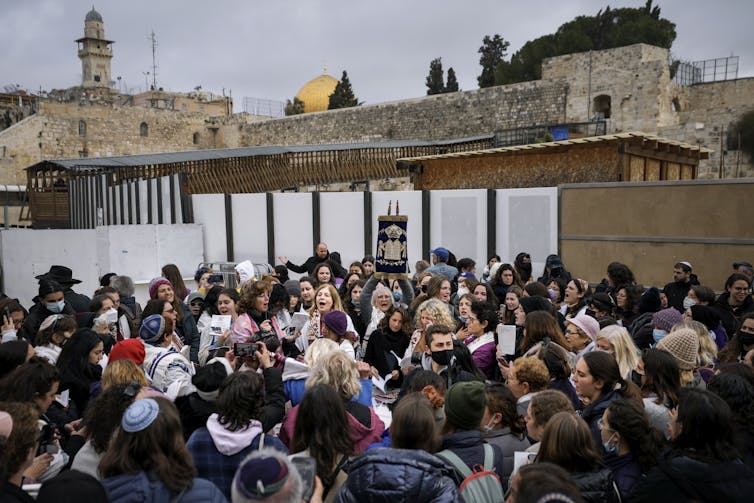Analysis: ‘You Are So Not Invited to My Bat Mitzvah’ speaks to the meaningful impact of religious rituals for Jewish girls

A hundred and one years before ‘You Are So Not Invited to My Bat Mitzvah’ was released, the first American Bat Mitzvah took place. (Apple TV+/Disney+/Netflix via AP)
BY Celia E. Rothenberg
December 11, 2023
Adam Sandler’s newest movie, You Are So Not Invited to My Bat Mitzvah, an adaptation of Fiona Rosenbloom’s 2005 eponymous young adult novel, is out in time for winter vacation and Netflix binging.
It is no surprise that this teen-themed film is a comedy, alternating between cringe-y and sweet scenes.
Yet the film also offers opportunities to consider how different genres of Jewish-themed films explore the potential of religious ritual to empower young Jewish women.
Girls’ relationships and futures
In the movie, Stacy (Sandler’s real-life daughter Sunny) and her best friend Lydia (Samantha Lorraine) have been planning their dreamy, over-the-top, conspicuous consumption Bat Mitzvah parties — New York City and Candyland themed, respectively — together since childhood.
Their friendship, however, is tested and, temporarily, broken by jealousy over a boy. This is followed by Stacy’s spread of untrue rumours on social media about Lydia. Most devastating of all, Stacy’s embarrassing videos of Lydia are mistakenly shown at Lydia’s Bat Mitzvah party which is consequently ruined.
When Stacy finds herself standing on the bima for her own Bat Mitzvah ritual, she is facing Lydia’s family’s empty seats, her own family, the congregation and the open Torah scroll.
It is then and there that Stacy admits her wrongdoings, expresses her real remorse for her actions and recognizes the importance of her Jewish community. When Lydia attends Stacy’s party (under parental duress), she discovers Stacy cancelled her own party plans so that Lydia could have the party she always dreamed of.
Reform-style American Judaism
You Are So presents viewers with a liberal, Reform-style congregation: the Rabbi is a woman, men and women sit together, the service is mostly in English and congregants are completely and unself-consciously integrated into secular American life.
Rabbi Rebecca the woman that you are.
(?: You Are So Not Invited to My Bat Mitzvah) pic.twitter.com/0KDBwQnPoE
— Netflix (@netflix) August 29, 2023
A hundred and one years before You Are So was released, the first American Bat Mitzvah took place. Judith Kaplan, daughter of Rabbi Mordechai Kaplan, read the blessings for, and a passage from, the Torah from her personal prayer book, not the Torah scroll itself.
This happened in Rabbi Kaplan’s sanctuary in the brownstone home of the Society for the Advancement of Judaism, a synagogue which would evolve over time into Reconstructionist Judaism. Influenced by American second wave feminism, Conservative synagogues widely adopted the Bat Mitzvah ritual by the 1960s. Reform synagogues did so by the 1970s. Jewish communities around the world now celebrate Bat Mitzvahs.
Women don’t traditionally read from the Torah
In non-Orthodox synagogue rituals today, girls read directly and in front of the whole congregation from the Torah scrolls. Traditional Orthodox Judaism, however, does not allow women to read publicly from the Torah scrolls. Orthodox congregations may call upon a young woman to speak about the meaning of the day’s Torah reading, or allow her to read from the Torah in a women’s-only service.
Today in Israel, clashes led by the ultra-Orthodox over the appropriateness of women reading from Torah scrolls at the Western Wall continue to erupt. At times, these have been violent.

Women’s performances of traditionally male rituals are largely rejected in Orthodox congregations, although some groups of Orthodox Jews continue to debate and ponder various acceptable possibilities for women.
‘By and for’ Orthodox women’s films
I watched You Are So while thinking about this ongoing theological divide between Orthodox and non-Orthodox communities, as well as the growth and appeal of “by and for women only” films produced by Orthodox Jewish women. These films feature only modestly dressed and “appropriately behaved” Jewish girls and women, and are intended to be viewed only by girls and women.
Among the most well-known producers of the genre is Robin Garbose. In 2000, she founded Kol Neshama, a Los Angeles-based performing arts conservatory “dedicated to providing professional artistic training and performance opportunities for girls and women in a Torah-observant setting and … the creation of distinctly Jewish film and stage productions.”
During Garbose’s female-only productions, unrelated men and women are not on set together. No production takes place on Shabbat or other Jewish festivals.
Gender-specific lessons
The films communicate gender-specific lessons for girls and women from an Orthodox point of view. Garbose, arguing for the importance of the by and for genre, wrote in the Jerusalem Post: “Our Biblical tradition teaches that the Jewish People and all humanity were not annihilated following the sin of the golden calf in the merit of the faithful women who did not participate in the event.”
This refers to the story related in Exodus 32. Aaron asked for gold jewelry from men and women in order to create a golden calf to be worshipped by the Israelites who demanded a god. It was the women who refused to give up their gold for the creation of the idol.
Interpretations of modesty
For Garbose, the sin of the golden calf today includes Jewish women both acting in and viewing inappropriate films, actions in contradiction with Jewish laws of modesty. Her films, including both their production and intended female-only audiences, are appropriate for all women to take part in, without risking their fidelity to Jewish law.
While Garbose would not portray Jewish women reading from the Torah publicly in her films, viewers of You Are So see Stacy do so. In fact, Stacy’s Torah reading is Ki Tissa, the story of the golden calf.
Garbose’s Kol Neshama films include Operation: Candlelight (2014), an “action adventure film for women and girls.”
In this film, girls at a religious Jewish school in California uncover a local criminal plot. They not only foil the plot, but also find that their truest selves are expressed when lighting Shabbat candles, the quintessential Jewish woman’s ritual responsibility.
Portraying Jewish women’s worlds
You Are So and Operation are seemingly worlds apart, despite being both filmed in California.
It seems clear that Sandler and Garbose are unlikely to agree on a variety of theological issues, including an interpretation of the golden calf. Yet they both find themselves in and portraying Jewish women’s worlds — Garbose in her work at Kol Neshama and Sandler, at least as I imagine him, the sole man at home with his two daughters and wife.
Garbose and Sandler share a focus on the potential of Jewish ritual, the Bat Mitzvah and Shabbat candlelighting respectively, to change and empower young Jewish women. Sandler and Garbose, remarkably, are in agreement, at least on this point.![]()
Celia E. Rothenberg, Associate Professor, Department of Religious Studies, McMaster University.
This article is republished from The Conversation under a Creative Commons license. Read the original article.


